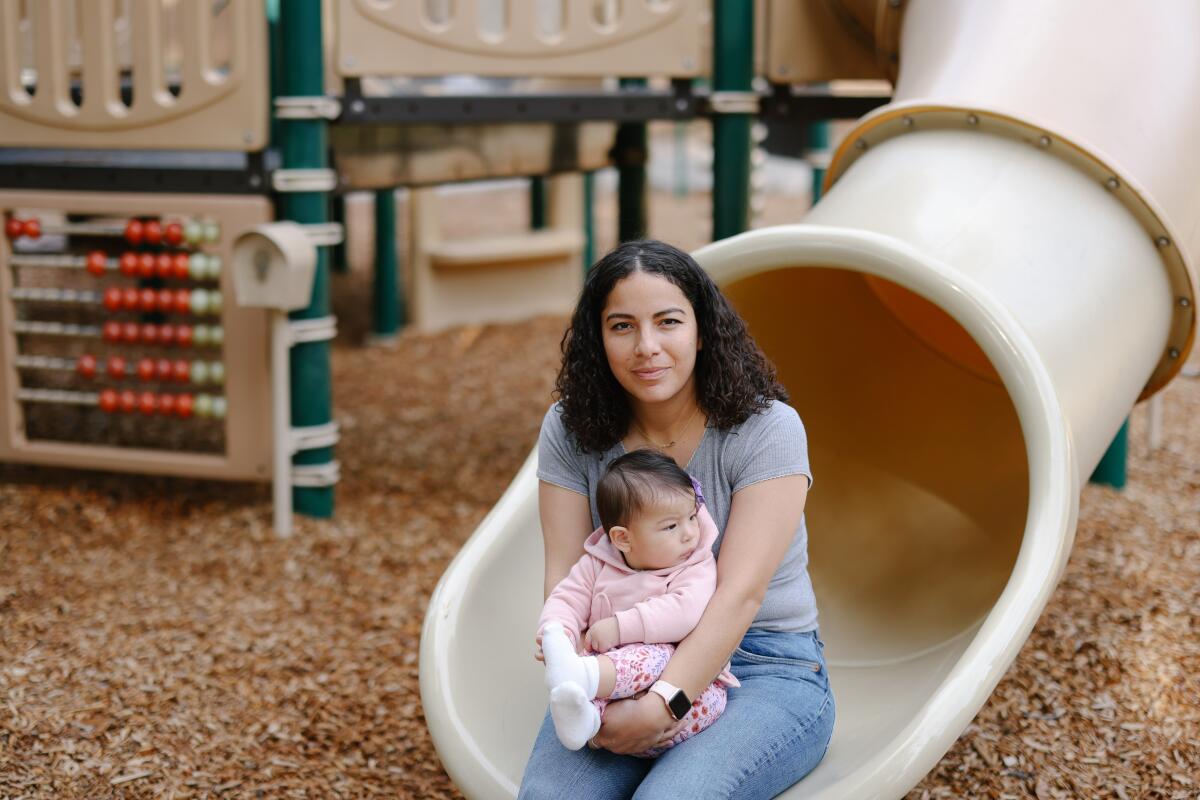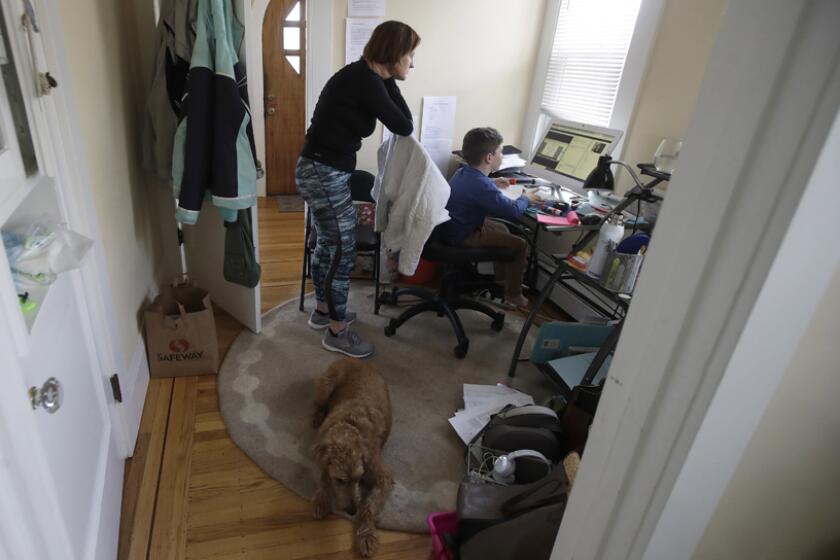‘I’m trying to stay afloat:’ California parents sound off on childcare crisis

- Share via
Nearly three years after the pandemic began, parents are still feeling a financial squeeze because of child care.
In December, 51,000 parents had to miss work because of child-care problems. That’s an improvement over October’s record high when 104,000 parents missed work, but it’s still greater than pre-pandemic levels, according to data from the Bureau of Labor Statistics.
Total employment for women with children under age 18 was at 24.7 million in November, an increase of about 199,000 compared with November 2019. But the unemployment rate for women with children under age 6 was 3.8% in November, slightly higher than the 3.6% recorded in November 2019.
Missed work — and even more serious ramifications, such as parents dropping out of the workforce or reducing their hours — has severe financial consequences for families.
Nationwide, parents lost a total of $8.3 billion in wages due to inadequate child care, according to a 2016 study. For businesses, that means lost productivity and absenteeism cost them $1,150 per working parent each year — and those figures were calculated before the pandemic, said Anna Powell, senior research and policy associate at the UC Berkeley Center for the Study of Child Care Employment.
COVID-19 then exacerbated the child-care industry’s problems. Caring for young children is expensive and labor costs make up a large portion of providers’ budgets. Many parents can’t afford the cost. Providers then can’t raise rates much higher than minimum wage without a stable and external source of funding, meaning child-care workers’ wages are low. That leads to high turnover and a shortage of workers. The pandemic accelerated the exodus of child-care workers from the industry, a steady drip, drip, drip from which the industry has not yet fully recovered.
The retreat by mothers with outside employment is a setback for women’s advances, both in corporate America and in narrowing the pay gap with men.
Child-care employment is still down almost 10% relative to pre-COVID-19 levels, said Jessica Brown, an assistant professor of economics at the University of South Carolina who focuses on the economics of the child-care market.
“We see that employment overall in other industries has, on average, fully recovered, but in the child-care industry, we’re still down,” she said.
The lack of availability and affordability has forced many parents, especially mothers, to put their own careers on hold or reduce their hours. But how can you balance that with household expenses?
The Times interviewed parents about how child-care issues have affected their work and what they’ve had to do to adjust. Here are three personal stories.
While child-care startups have seen an influx of money and interest from investors in the last year, the industry’s challenges run deep.
‘More than half of my monthly paycheck’

Sofia Tavitian loved her job teaching third-graders.
But as the so-called tripledemic of COVID-19, flu and respiratory syncytial virus, or RSV, ravaged schools and day-care centers during the fall, she grew nervous about sending her then-4-month-old daughter to day care once her maternity leave ended. Hiring a nanny was out of the question.
“It would have been more than half of my monthly paycheck,” said Tavitian, 33, who teaches in the Los Angeles Unified School District. “That was just not realistic.”
The single mom decided that if anyone was going to care for her daughter at that young age, she wanted it to be her. In November, she took an unpaid leave of absence from her job at LAUSD until August. By then, her daughter will be more than a year old, and Tavitian said she’d feel more comfortable sending her to day care or enrolling her in preschool.
“Financially, it was just better because I would save that money doing the job I knew I wanted,” she said.
The decision has come with financial consequences. Tavitian was briefly uninsured when she went on her leave of absence before signing up for Medi-Cal. She also moved back into her childhood home, where she lives with her father.
“If I had to pay rent, I don’t know what on Earth I would have done,” said Tavitian, who lives in Eagle Rock. “It’s really easy to say, ‘Just put your kid in day care or put your kid in child care’ ... but it takes a toll on us.”
‘Financially, it’s been hard’

Lily Marquez has put her career on hold twice because of child-care issues.
The first time was about six years ago, when she quit her 10-year career as a university financial aid administrator to become a stay-at-home mom and care for her then-newborn daughter and young son since she couldn’t find anyone to take care of two babies. At that time, child care cost more than her condo mortgage in Alameda County, she said.
She later returned to the workforce and was employed as an in-home caregiver for an elderly woman until about a year ago, when her daughter was sent home from school because of a COVID-19 exposure on campus. With no other child-care options available, Marquez had to take her daughter to work with her at her patient’s home.
The woman was in her 90s with respiratory issues and required 24-hour care. Although Marquez needed the income, she decided to quit rather than expose her patient to COVID-19.
“I can’t do this to you,” Marquez, 41, remembers telling her patient. “I don’t want for you to get exposed because I know it’s detrimental. I’m sorry.”
During this time, she also separated from her husband and moved from San Francisco to Contra Costa County to be near family. Her children changed schools and her daughter’s new kindergarten class is in session from 8 to 11:30 a.m., making it hard for her to find work. Unlike in San Francisco, after-school programs are not as available or affordable.
All of her nearby family members work, limiting their ability to help with child care. She said she hopes it will be easier once her daughter goes into first grade and has a longer school day.
“Financially, it’s been hard over here,” Marquez said. “I’m trying to stay afloat. It’s been difficult.”
‘I’m sure we’ll make it work for another two years’

Roger Chong built a thriving home services business during the pandemic.
In a major change from his previous careers in airline entertainment and production management for reality TV shows such as “Fear Factor” and “Wipeout,” Chong now installs home furnishings, mounts TVs and builds furniture.
It keeps him closer to home than his reality TV jobs — something that was especially important after he and his wife welcomed their first child in November 2020. And he made more money working for himself than he ever did when he was on a company’s payroll, Chong said.
But after his wife’s roughly six-month maternity leave ended, “things were getting a lot rockier,” Chong said.
The cheapest child care they could find was $500 a week, part-time and limited to children who were potty-trained. Their 2-year-old son is not, so his fee would be higher. Chong and his wife occasionally get help with child care from family, but not on a consistent basis.
“We’d pretty much be working to pay for child care,” said Chong, 38, who lives in Carson. “We’re pretty much in a rip curl of making money to spend money.”
His wife’s full-time job as a nurse provides the family with health benefits and a stable income, so Chong changed his work schedule to fit hers. He had to cut down his work availability from as many as six days a week to two or three. Sometimes he’s gone up to two weeks without being able to work. And since his availability is limited, it can be hard to schedule future jobs when customers want their TVs mounted sooner than three weeks out.
To supplement his income, Chong drives for DoorDash or UberEats at night after his son is asleep and can make about $400 to $500 a week. Sometimes he’ll drive until 4 a.m., but other days, he’s too tired to go out.
Maybe more options will be available after his son is potty-trained, Chong mused. The last-resort plan is to wait until his son is 5 and goes to kindergarten, and then Chong could go back to his business full time.
“We made it work for two, two and a half years now,” he said. “I’m sure we’ll make it work for another two years.”
More to Read
Inside the business of entertainment
The Wide Shot brings you news, analysis and insights on everything from streaming wars to production — and what it all means for the future.
You may occasionally receive promotional content from the Los Angeles Times.












